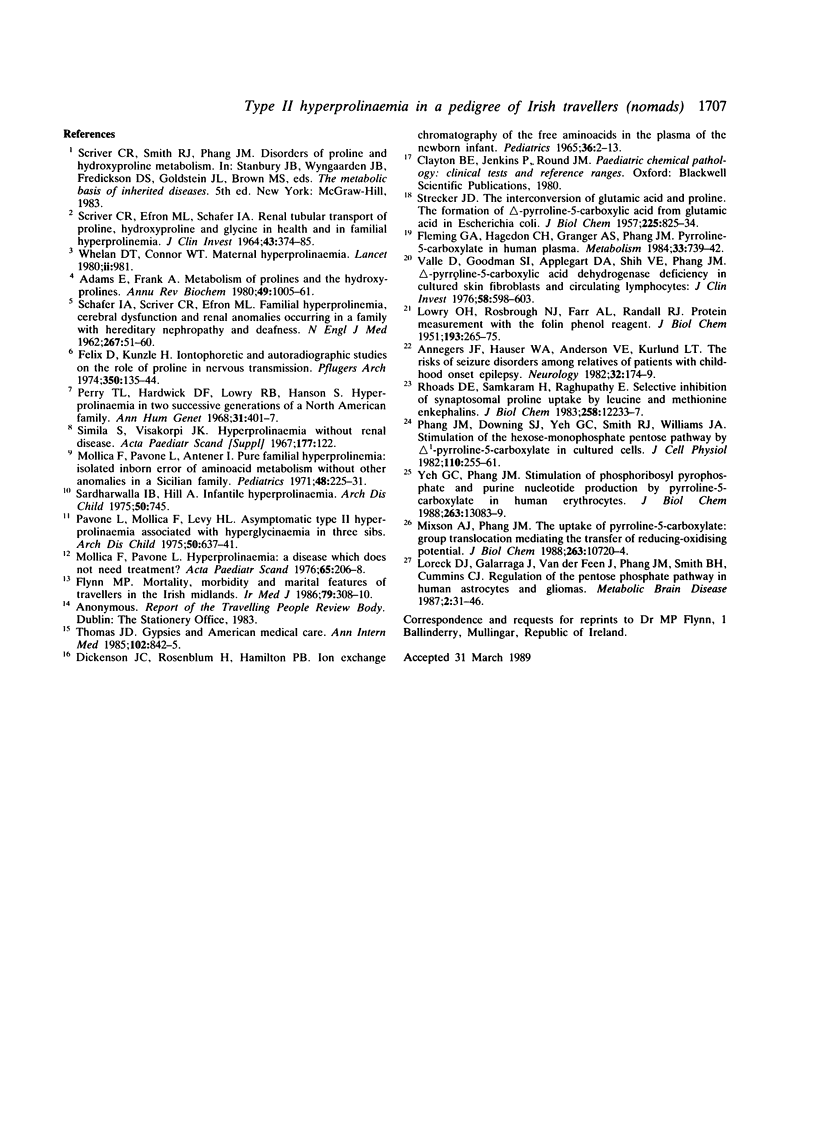Abstract
We describe a study of 312 subjects in 71 families near related to a proband with type II hyperprolinaemia. The subjects were Irish travellers (nomads) among whom consanguineous marriage and high fertility are common. Thirteen additional cases of type II hyperprolinaemia were discovered; all were offspring of consanguineous unions. A further 50 subjects were found to have mild hyperprolinaemia. We found a strong association between type II hyperprolinaemia and seizures during childhood but no significant association with mental handicap. Most adults with type II hyperprolinaemia enjoyed normal health and there was no evidence that maternal hyperprolinaemia compromised fetal development. The documented association between type II hyperprolinaemia and seizures may be related to the neuromodulatory or reducing-oxidising effects of proline and pyrroline-5-carboxylate, respectively, that has been shown in vitro. Alternatively, another genetic defect closely linked to the type II hyperprolinaemia allele could be the explanation.
Full text
PDF








Selected References
These references are in PubMed. This may not be the complete list of references from this article.
- Adams E., Frank L. Metabolism of proline and the hydroxyprolines. Annu Rev Biochem. 1980;49:1005–1061. doi: 10.1146/annurev.bi.49.070180.005041. [DOI] [PubMed] [Google Scholar]
- Annegers J. F., Hauser W. A., Anderson V. E., Kurland L. T. The risks of seizure disorders among relatives of patients with childhood onset epilepsy. Neurology. 1982 Feb;32(2):174–179. doi: 10.1212/wnl.32.2.174. [DOI] [PubMed] [Google Scholar]
- DICKINSON J. C., ROSENBLUM H., HAMILTON P. B. ION EXCHANGE CHROMATOGRAPHY OF THE FREE AMINO ACIDS IN THE PLASMA OF THE NEWBORN INFANT. Pediatrics. 1965 Jul;36:2–13. [PubMed] [Google Scholar]
- Felix D., Künzle H. Iontophoretic and autoradiographic studies on the role of proline in nervous transmission. Pflugers Arch. 1974;350(2):135–144. doi: 10.1007/BF00586233. [DOI] [PubMed] [Google Scholar]
- Fleming G. A., Hagedorn C. H., Granger A. S., Phang J. M. Pyrroline-5-carboxylate in human plasma. Metabolism. 1984 Aug;33(8):739–742. doi: 10.1016/0026-0495(84)90215-4. [DOI] [PubMed] [Google Scholar]
- Flynn M. Mortality, morbidity and marital features of travellers in the Irish Midlands. Ir Med J. 1986 Nov;79(11):308–310. [PubMed] [Google Scholar]
- LOWRY O. H., ROSEBROUGH N. J., FARR A. L., RANDALL R. J. Protein measurement with the Folin phenol reagent. J Biol Chem. 1951 Nov;193(1):265–275. [PubMed] [Google Scholar]
- Loreck D. J., Galarraga J., Van der Feen J., Phang J. M., Smith B. H., Cummins C. J. Regulation of the pentose phosphate pathway in human astrocytes and gliomas. Metab Brain Dis. 1987 Mar;2(1):31–46. doi: 10.1007/BF00999507. [DOI] [PubMed] [Google Scholar]
- Mixson A. J., Phang J. M. The uptake of pyrroline 5-carboxylate. Group translocation mediating the transfer of reducing-oxidizing potential. J Biol Chem. 1988 Aug 5;263(22):10720–10724. [PubMed] [Google Scholar]
- Mollica F., Pavone L., Antener I. Pure familial hyperprolinemia: isolated inborn error of aminoacid metabolism without other anomalies in a Sicilian family. Pediatrics. 1971 Aug;48(2):225–231. [PubMed] [Google Scholar]
- Mollica F., Pavone L. Hyperprolinaemia: a disease which does not need treatment? Acta Paediatr Scand. 1976 Mar;65(2):206–208. doi: 10.1111/j.1651-2227.1976.tb16538.x. [DOI] [PubMed] [Google Scholar]
- Pavone L., Mollica F., Levy H. L. Asymptomatic type II hyperprolinaemia associated with hyperglycinaemia in three sibs. Arch Dis Child. 1975 Aug;50(8):637–641. doi: 10.1136/adc.50.8.637. [DOI] [PMC free article] [PubMed] [Google Scholar]
- Perry T. L., Hardwick D. F., Lowry R. B., Hansen S. Hyperprolinaemia in two successive generations of a North American Indian family. Ann Hum Genet. 1968 May;31(4):401–407. doi: 10.1111/j.1469-1809.1968.tb00573.x. [DOI] [PubMed] [Google Scholar]
- Phang J. M., Downing S. J., Yeh G. C., Smith R. J., Williams J. A., Hagedorn C. H. Stimulation of the hexosemonophosphate-pentose pathway by pyrroline-5-carboxylate in cultured cells. J Cell Physiol. 1982 Mar;110(3):255–261. doi: 10.1002/jcp.1041100306. [DOI] [PubMed] [Google Scholar]
- Rhoads D. E., Peterson N. A., Raghupathy E. Selective inhibition of synaptosomal proline uptake by leucine and methionine enkephalins. J Biol Chem. 1983 Oct 25;258(20):12233–12237. [PubMed] [Google Scholar]
- SCHAFER I. A., SCRIVER C. R., EFRON M. L. Familial hyperprolinemia, cerebral dysfunction and renal anomalies occuring in a family with hereditary nephropathy and deafness. N Engl J Med. 1962 Jul 12;267:51–60. doi: 10.1056/NEJM196207122670201. [DOI] [PubMed] [Google Scholar]
- SCRIVER C. R., EFRON M. L., SCHAFER I. A. RENAL TUBULAR TRANSPORT OF PROLINE, HYDROXYPROLINE, AND GLYCINE IN HEALTH AND IN FAMILIAL HYPERPROLINEMIA. J Clin Invest. 1964 Mar;43:374–385. doi: 10.1172/JCI104922. [DOI] [PMC free article] [PubMed] [Google Scholar]
- STRECKER H. J. The interconversion of glutamic acid and proline. I. The formation of delta1-pyrroline-5-carboxylic acid from glutamic acid in Escherichia coli. J Biol Chem. 1957 Apr;225(2):825–834. [PubMed] [Google Scholar]
- Similä S., Visakorpi J. K. Hyperprolinemia without renal disease. Acta Paediatr Scand. 1967;(Suppl):122+–122+. doi: 10.1111/j.1651-2227.1967.tb05259.x. [DOI] [PubMed] [Google Scholar]
- Thomas J. D. Gypsies and American medical care. Ann Intern Med. 1985 Jun;102(6):842–845. doi: 10.7326/0003-4819-102-6-842. [DOI] [PubMed] [Google Scholar]
- Valle D., Goodman S. I., Applegarth D. A., Shih V. E., Phang J. M. Type II hyperprolinemia. Delta1-pyrroline-5-carboxylic acid dehydrogenase deficiency in cultured skin fibroblasts and circulating lymphocytes. J Clin Invest. 1976 Sep;58(3):598–603. doi: 10.1172/JCI108506. [DOI] [PMC free article] [PubMed] [Google Scholar]
- Whelan D. T., Conner W. T. Maternal hyperprolinaemia. Lancet. 1980 Nov 1;2(8201):981–982. doi: 10.1016/s0140-6736(80)92142-x. [DOI] [PubMed] [Google Scholar]
- Yeh G. C., Phang J. M. Stimulation of phosphoribosyl pyrophosphate and purine nucleotide production by pyrroline 5-carboxylate in human erythrocytes. J Biol Chem. 1988 Sep 15;263(26):13083–13089. [PubMed] [Google Scholar]


